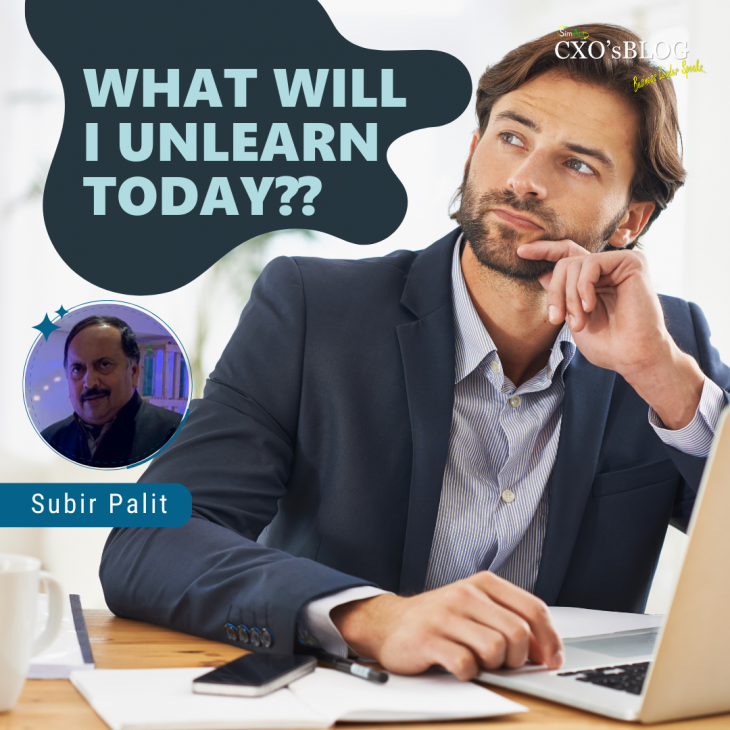Author: Subir Palit
There is a phrase in Buddhism, “kill the Buddha”, it means that the ideas you have learned to bring you to this point of clarity need to be let go of, if you are to go further and step into your power.
But, why exactly would we want to let go or unlearn?
Does what we already know prevents us from knowing more?
Right from our childhood we are programmed to answer every day at home or school,
What did you learn today?
You must learn from your mistakes? And so on…
These are only illustrations of a mindset requiring you for piling onto your existing knowledge in addition to your learning.
Can you or your Organisation truly advance if you’re not willing to acknowledge that what brought you where you are today might not be the best way to keep you going optimally where you want to go?
Flexibility in mindset is so critical in today’s world.
Changing mindsets, habits and systems is complex and involves altering conceptions. It’s not easy altering personal identities, traditions and long-standing assumptions. In organisations resistance to change arises through policies, routines, organizational structures, and even shared values and identities that interlock to block unlearning and change.
The idea to come to work every day and ask yourself, “What will I unlearn today”, is so new and sounds anomalous.
Unlearning is about moving away from something rather than moving towards something.
Unlearning to me is to attempt to let go of what we have already learned or acquired. It is not about what is right or wrong. It is about being open to and exploring something that lies underneath the judgment, underneath the right and the wrong. One way to begin unlearning is to seek additional knowledge in familiar areas and then use that new knowledge to start pulling up and modifying old knowledge.
Another form of unlearning could be what Prof Reg Revens had referred to as “Action learning”. According to him action learning provides a powerful stimulus for continuous change, enabling individuals and organisations to grow and learn dynamically, rather than remaining static or fixed in one set of circumstances.
His action learning concept is based on the formula:
L=P+Q .
Where L is programmed knowledge. P is things that people have been taught or have learned through experience plus questioning skills and Q is ability to challenge programmed knowledge using the stimulus of real-life problems.
The basic idea of action learning is simple as it combines knowledge that people have been taught with skills that people have learned from experience and their inquisitiveness.
It has been proved individual action learning programs have been very powerful to bring about individual change, but they cannot change organisation culture. The one approach also known as classical Revens model combines individual development with organisational change. The method applies the action learning on an in plant basis, using problems that exist within the company ie, real problems, which needs to be solved. The typical ‘AL’ structure applied in this model is, the directors and senior managers are cast as ‘clients’, middle managers as ‘facilitators’ and plant supervisors and his subordinates as ‘fellows’ forming action learning teams. The whole process is coordinated by ‘external facilitators. This approach ensures that all the managers and supervisors are involved and work towards achieving the desired organisational goal.
The knowledge what we have learned over the years is needed but in conditions of rapid changes and almost new challenges every day in this ever-changing world it is not enough for survival. One must continue to unlearn, learn and relearn in order to stay relevant in today’s modern, digital space. Change is continual, and in order to stay current and not become obsolete, unlearning is a vital component.
Unfortunately, the most important aspect of learning, the process of unlearning is undervalued and overlooked by many individuals and organisations even today.
“The illiterate of the 21st century will not be those who cannot read and write, but those who cannot learn, unlearn, and relearn” —- Alvin Toffler.
We because “SOGA” leaders (share of Gross Adds) in the circle and doubled our customer acquisition rate to almost 4.5 lacs / month. We also improved the quality of our acquisition through smart use of incentive plans and schemes for our distributor and retailers. Our revenues started growing month on month and soon we became EBIDTA positive. Not only did we receive the “Best Performing Circle Award within Aircel” but we were also recognised by the industry with the Telecom Leadership Award as the fastest growing Telecom Service Provider in Delhi NCR for 3 consecutive years.
Learnings
- We were able to differentiate a “commodity” product (prepaid plan) by superior execution on ground in a fiercely competitive environment
- We were able to win despite having severe network and other budgetary constraints (no data spectrum, half the number of towers compared to competition, no budgets for ATL and comparatively low BTL budgets, less budgets to attract talent etc). We focussed on things which we could change
- Finally winning starts by winning in the mind first – a great strategy executed along with great processes and people – these made all the difference
